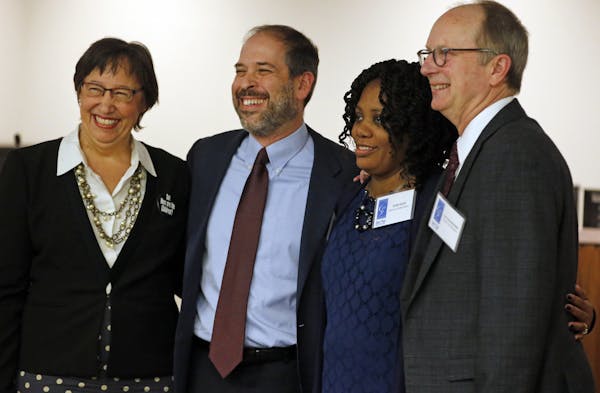Negotiators for the St. Paul School District and the union representing its teachers continued discussions into the weekend in hopes of averting the city's first teacher strike since 1946.
Progress of varying degrees was reported throughout the week, but the two sides face a formidable challenge as Tuesday's walkout date looms: The district wants to hold new spending for teachers to $2.07 million a year, while the union is pushing wide-ranging proposals totaling $159 million over two years.
"That gap is unusually big. I think that's what's so unique about this situation," said David Larson, a professor of labor law at Mitchell Hamline School of Law in St. Paul. Complicating matters further, he said, is the district's financial straits.
Strikes leave people hurt, he said. For St. Paul, a walkout also increases the risk of more students fleeing to charter schools and neighboring districts — in turn inflicting additional damage to the bottom line, he added.
On Saturday, Superintendent Joe Gothard took part in negotiations. Eight months into the job, he is optimistic a deal can get done and eager to get on with the task of completing a new strategic plan for the district.
At City Hall, Mayor Melvin Carter, himself a product of St. Paul Public Schools, is hoping for a settlement as he nears his third month in office. On Saturday, he spoke to the two bargaining teams, encouraging them to continue to work together.
This year's negotiations find the St. Paul Federation of Teachers moving once again beyond traditional salary and benefit concerns to proposals to improve learning conditions for students and staff.
"We know this school district can find money when they want to," Nick Faber, the union's president, said in a statement last week. "We need them to find money to fund programs for our English learners and special education students so we can provide the education our students deserve."
Board Member Steve Marchese, who has worked closely with community members in the past two years to keep cuts from affecting classrooms, has said the district's fiscal challenges are real, and the union's proposals did not reflect that reality.
"I will not vote for a contract that imperils the fiscal health of the district and our future," he said.
A trend in talks
For each of the past four bargaining cycles, the union has used the contract to try to influence what often could be seen as managerial policy.
In 2012, it won concessions in the areas of class sizes and special education caseloads, and in 2014, after parents joined teachers in rallying outside school district headquarters, the union succeeded in getting class size ranges inserted into the contract and in negotiating multiple support staff hires.
A year later, a union-powered Caucus for Change movement ousted school board incumbents and elected a new board majority that pledged support to contract positions that later would be agreed to in 2016 — with final-hour participation from two of the newcomers, Marchese and Jon Schumacher.
In recent years, the union has drawn on parents and community members to help craft its positions, and for this year's talks, it assembled a "TIGER team" through which it created a new funding strategy: pressuring corporations and nonprofits that benefit from tax breaks or their tax-exempt status to contribute to schools. It also took to task the board members it helped elect by suggesting they were backing corporate and nonprofit interests over those of their students.
"Whose side are you on?" the union asked pointedly of Schumacher, then the board's chairman, in December.
The confrontational tactics were criticized in recent Op-Ed pieces by two longtime teachers who helped lead the union in the past.
Said Faber, "We are going to fight for what our students need and not apologize for working to create the schools St. Paul children deserve."
The strike was backed by 85 percent of teachers who voted on Jan. 31, but the union has declined to give the actual number of teachers voting.
Negotiating positions
The St. Paul district has been in budget-cutting mode for three consecutive years, with initial deficits of $19.3 million in 2015-16, $15.1 million in 2016-17 and $27.3 million in 2017-18.
Last summer, the board found the resources needed to hire 10 new teachers of English-language learners after a state audit uncovered shortcomings in the program and the federation led a petition drive promoting changes.
English-language learners now represent one-third of the student population in the state's second-largest district.
At the bargaining table, the union has pushed for additional supports in those ELL classrooms, as well as proposals to reduce class sizes, expand new approaches to discipline referred to as "restorative practices" and boost the numbers of nurses, librarians, social workers and counselors — plus give teachers 2.5 percent raises annually. On Friday night, it reported "significant positive movement" on restorative practices.
To help cover contract costs, the federation has suggested that the district dip into its unassigned reserve funds. But the $31 million in that account represents 5.7 percent of the district's general fund, and the board's policy is to not go below 5 percent — a move it says could hurt the district's bond and credit ratings.
As he watches, Larson said a case certainly can be made that schools need more resources. A strike, as such, could provide a jolt to the state to come up with new revenue. But he is worried about the harm that comes with a walkout, and is glad people still are talking.
"It is always tough to predict, but I think we're in a state that has — compared to other places — been better, less combative," he said. "I am going to have to say that I am still hopeful they won't strike."
Anthony Lonetree • 612-673-4109
Carolyn Parnell, 'trailblazer' who served as Minnesota's first IT commissioner, dies


